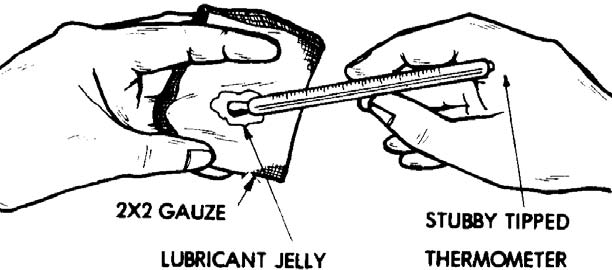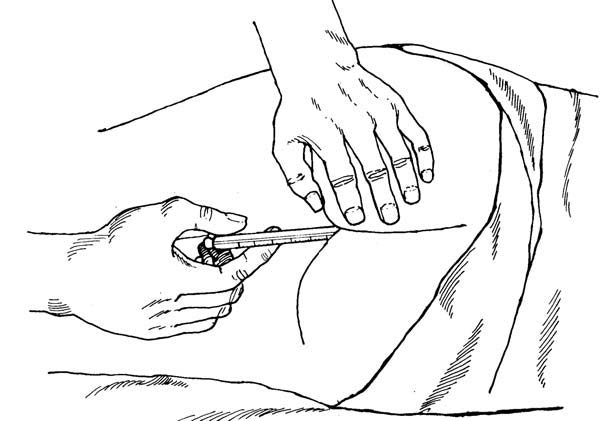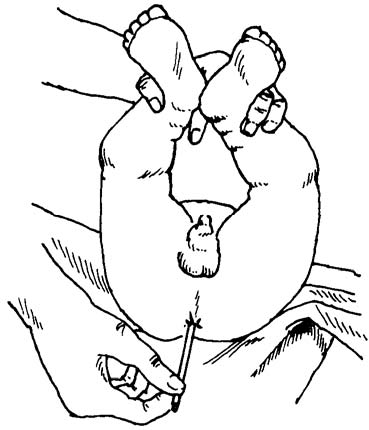Use the following procedures when taking a patient’s rectal temperature.
a. Wash Hands.
Perform a patient care hand wash.
b. Gather Materials.
You will need to assemble the following items:
(1) Glass rectal thermometer(s). Rectal thermometers will normally be in a tray such as was shown in figure 2-7. The difference between on oral thermometer tray and a rectal thermometer tray is in the type of thermometers in the “clean” container.
(2) Lubricant. You will need a water-soluble lubricant. A lubricated thermometer can be inserted into the rectum much easier than a thermometer that has not been lubricated. If the lubricant is in a jar, you will need a tongue depressor or other instrument to transfer the lubricant from the jar to the gauze pad.
(3) Gauze pads. The gauze pads are used to lubricate the thermometer and to wipe the thermometer after you remove it from the patient’s rectum.
(4) Timepiece. A watch or clock with a second hand is preferred.
(5) Writing materials. You will need a pencil or pen and something on which to write (form, note pad, etc.).
c. Verify That The Rectal Route Should Be Used.
A rectal temperature should be taken when one of the following conditions exist:
(1) The physician or nurse has ordered a rectal temperature and the patient’s condition does not contraindicate taking a rectal temperature.
(2) The physician or nurse has not stated the method to be used, the oral method is contraindicated (paragraph 2-17b), and the rectal is not contraindicated (paragraph 2-20b).
d. Verify Patient’s Identity.
Be sure to verify that you are taking the temperature of the proper patient.
e. Tell Patient About Procedure.
Tell the patient that you are going to take his temperature rectally. Be sure to explain how you want the patient to position himself (paragraph f) and inform him when you are going to insert and remove thermometer.
f. Position Patient.
Have the patient to lie on his side with his top knee flexed (bent). (This is called the “Sims’s” position.”) Arrange the patient’s clothing (gown, pajamas, etc.) and bed sheet so that the rectal area is clearly exposed, but so that the patient is not exposed unnecessarily.
g. Prepare Lubricant.
Before the rectal thermometer is inserted, the bulb of the thermometer must first be lubricated. Your SOP will indicate what type of lubricant is to be used (usually a type of jelly or mineral oil). Prepare the lubricant by placing some of the lubricant on a gauze pad.
If the lubricant is in a jar, a tongue depressor can be used to transfer some of the lubricant from the jar to the pad. A thermometer should not be dipped into a jar of lubricant since this action could contaminate the lubricant remaining in the jar.
h. Examine Thermometer.
Pick up a thermometer from the “clean” container. Be sure to avoid touching the part of the thermometer that will be inserted into the patient’s rectum. Make sure that the thermometer is a rectal thermometer (red color-coded and not long-tipped) and that its temperature reading is below 94º F.
(1) If the thermometer is not a rectal thermometer, obtain a rectal thermometer.
(2) If the thermometer reads 94º F or higher, shake the thermometer down until the reading is below the 94º F mark.
i. Lubricate Thermometer.
The bulb of the thermometer is lubricated in order to make it easier to insert the thermometer into the rectum and to keep the muscles inside the rectum from being irritated by a dry rectal thermometer. (If the muscles are irritated, they may contract and try to push the thermometer out of the rectum.)
Lubricate the thermometer by putting the tip of the thermometer bulb into the lubricant on the gauze (figure 2-11). Then use the gauze pad to spread the lubricant over the entire bulb of the thermometer and over two inches of the stem. After you have lubricated the thermometer, discard the gauze pad into an appropriate waste container.

j. Insert Thermometer.
Insert the thermometer into the patient’s rectum using the following steps:
(1) Tell the patient that you are going to insert the thermometer.
(2) Using your free hand (the hand that is not holding the thermometer), lift the patient’s upper buttock slightly (see figure 2-12) until the anus is clearly exposed.

(3) Have the patient take a deep breath and then release the breath. (This will help to relax the sphincter muscle that controls the opening and closing of the anus.)
(4) Insert the lubricated bulb of the thermometer through the anus opening.
(5) Continue to gently insert the thermometer until one to two inches of the thermometer has been inserted.
(6) Release your hold on the patient’s upper buttock, but do not let go of the thermometer.
NOTE: If the patient is an infant, expose the rectal area by laying the infant on his back and lifting both legs into the air (figure 2-13). Insert the lubricated thermometer until 1/2 to 3/4 inches has been inserted.

k. Hold Thermometer in Place for Two Minutes.
An accurate temperature reading can be obtained within two minutes. You must hold the thermometer in place during this time in order to prevent the thermometer from being expelled (pushed out) of the rectum and to prevent the thermometer from entering further into the rectum.
l. Remove Thermometer.
After at least two minutes have elapsed, remove the thermometer from the patient’s rectum.
(1) Tell the patient that you are going to remove the thermometer.
(2) Using your free hand, lift the upper buttock again.
(3) Gently pull the thermometer from the patient’s rectum.
(4) Release the upper buttock.
(5) Cover the patient’s rectal area (reposition gown, pajamas, bed sheet, and so forth).
m. Wipe Thermometer.
Use a gauze pad to wipe the thermometer. Begin near the hand that is holding the thermometer and wipe to the bulb in one quick, downward stroke. Discard the used gauze pad into a waste container.
n. Read Thermometer.
Hold the thermometer at eye level and read the temperature to the nearest 0.2 ºF (or 0.1º C).
o. Record Reading.
Write the patient’s temperature reading on the form or piece of paper. After you record the temperature reading, write a circled “R”( ® )above the reading. The ® indicates that the temperature is a rectal temperature rather than an oral temperature.
p. Place Thermometer in “Used” Container.
After recording the patient’s rectal temperature, place the used thermometer into the container marked “used” on the thermometer tray.
q. Wash Hands.
Perform a patient care hand wash after taking a rectal temperature.
r. Turn in Tray.
After you have completed taking rectal temperatures, turn in the temperature tray according to local procedures. The thermometers must be decontaminated before they are used again.
